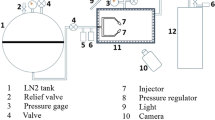Abstract
At low Weber numbers, the aerodynamic forces due to the interaction between gas and liquid do not influence liquid atomization processes. In these situations, atomization processes depend on issuing liquid flow characteristics only. According to the literature, the atomization efficiency is best when the issuing liquid flow shows a high turbulence level. Some injectors are based on this concept and promote the production of turbulence by imposing deflection of the flow inside the nozzle. However, many studies indicate that the level of turbulence does not solely control the atomization efficiency. By conducting a numerical and experimental study on the behavior of cavity nozzles, it is found that internal flow deflection to produce turbulence also produces a non-axial flow component at the nozzle exit whose effect on the atomization process is of paramount importance. Indeed, the results show that the surface energy produced during the atomization process is linearly dependent on the sum of the turbulent kinetic energy and the non-axial kinetic energy at the nozzle exit. This sum represents the energy available for the atomization process, and the influence of the injection pressure as well as of the nozzle geometry on this energy is investigated.















Similar content being viewed by others
References
Amer AA, Lai MC (1995) Time-resolved measurements in transient port injector sprays. SAE Tech Pap Ser 950509
Chen JL, Wells M, Creehan J (1998) Primary atomization and spray analysis of compound nozzle gasoline injectors. J Eng Gas Turbines Power 120:237–243
Chin JS, Nickolaus D, Lefebvre AH (1986) Influence of downstream distance on the spray characteristics of pressure-swirl atomizers. J Eng Gas Turbines Power 108:219–224
Dodge LG (1984) Change of calibration of diffraction-based particle sizers. Opt Eng 23:626–630
Dodge LG, Rhodes DJ, Reitz RD (1987) Drop-size measurement techniques for sprays: comparison of malvern laser-diffraction and aerometric phase/doppler. Appl Opt 26:2144–2154
Evers LW (1994) Analogy between atomization and vaporization based on the conservation of energy. SAE Tech Pap Ser 940190
Glodowski ML, Michalek DJ, Evers LW (1996) The use of results from computational fluid dynamic fuel injector modeling to predict spray characteristics. SAE Tech Pap Ser 961191
Heyse J, Schatz F, Ader B, Schlerfer J, Haubold S (1997) Electroformed multilayer orifice plate for improved fuel injection characteristics. SAE Tech Pap Ser 971070
Lai MC, Zhao FQ, Amer AA, Chue TH (1994) An experimental and analytical investigation of the spray structure from automotive port injectors. SAE Tech Pap Ser 941873
Leroux S, Dumouchel C, Ledoux M (1996) The stability curve of Newtonian liquid jets. Atomization Sprays 6:623–641
Malot H, Dumouchel C (2001) Experimental investigation of the drop-size distribution of sprays produced by a low-velocity Newtonian cylindrical liquid jet. Atomization Sprays 11:227–254
Michalek DJ, Peschke BD, Evers LW (1997) Computational design of experiments for compound fuel injector nozzles. SAE Tech Pap Ser 971617
Nagasaka K, Takagi T, Koyanagi K, Yamauchi T (2000) The development of fine atomization injector. JSAE 21:309–313
Parrish S, Evers L (1995) Spray characteristics of compound silicon micro machined port fuel injector orifices. SAE Tech Pap Ser 950510
Ren WM, Sayar H (2001) Influence of nozzle geometry on spray targeting and atomization for port fuel injector. SAE Tech Pap Ser 2001–0608
Rivette SM, Evers LW (1996) Compound port fuel injector nozzle droplet sizes and spray patterns. SAE Tech Pap Ser 960114
Rizk NK, Lefebvre AH (1984) Influence of downstream distance on simplex atomizer spray characteristics. Am Soc Mech Eng 84-WA/HT-25
Sterling AM, Sleicher CA (1975) The instability of capillary jets. JFM 68:477–495
Triballier K, Cousin J, Dumouchel C (2002) Relations between internal flow structures and disintegration processes in spray formation. In: Proceedings of the ILASS-Europe 2002, Zaragoza, Spain, September 2002
Triballier K, Dumouchel C, Cousin J, (2003) Analysis of double-peak drop-size distribution from the application of the maximum entropy formalism. In: Proceedings of the ICLASS 2003, Sorento, Italy, July 2003
Zhao FQ, Lai MC (1995) The spray characteristics of automotive port fuel injection—a critical review. SAE Tech Pap Ser 950506
Acknowledgements
The authors would like to warmly thank Cyril Mauger for its precious help in the present experimental work.
Author information
Authors and Affiliations
Corresponding author
Rights and permissions
About this article
Cite this article
Dumouchel, C., Cousin, J. & Triballier, K. On the role of the liquid flow characteristics on low-Weber-number atomization processes. Exp Fluids 38, 637–647 (2005). https://doi.org/10.1007/s00348-005-0944-1
Received:
Revised:
Accepted:
Published:
Issue Date:
DOI: https://doi.org/10.1007/s00348-005-0944-1




